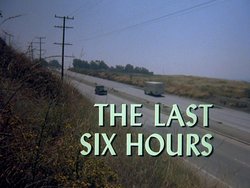Last Six Hours (Quincy, M.E.)
| The Last Six Hours | ||||||||||||||||||||||||||||||||||||||
|---|---|---|---|---|---|---|---|---|---|---|---|---|---|---|---|---|---|---|---|---|---|---|---|---|---|---|---|---|---|---|---|---|---|---|---|---|---|---|

| ||||||||||||||||||||||||||||||||||||||
|
Episode Quote
"No more phones, no more headaches, no more Asten, no more Monahan…" ~ Dr. Quincy (just before getting pulled back into an emergency)
Episode Overview
The Last Six Hours is the premiere episode of the third season of the television series Quincy, M.E.. It aired on NBC on September 21, 1978. Quincy is pulled from a much-needed vacation when a roadside accident leads to a medical mystery involving a mysterious toxin, exposing both law enforcement and his own assistant, Sam, to deadly symptoms.
Table of Contents
Application of The QME Episode Laws
The Last Six Hours strongly follows all four QME Episode Laws:
✅ Law 1: Seek the truth and bring justice to the victim. Quincy refuses to accept a simple accident or disease as the cause of death. His investigation reveals a hidden toxin, preventing more deaths and correcting the misclassification of a fatal crash.
✅ Law 2: Explore social and ethical issues. This episode raises awareness about environmental hazards and institutional failure to detect invisible threats that affect the public.
✅ Law 3: Address controversial topics with sensitivity. The episode touches on systemic gaps in emergency preparedness and how medical assumptions can be deadly.
✅ Law 4: Maintain forensic accuracy. Forensic pathology is at the heart of the story—Quincy uses toxicology screens, autopsies, and epidemiological tracing to identify the mystery poison and save Sam’s life.
Episode Synopsis
While on vacation with Barbara, Quincy comes across a roadside accident involving a woman who soon dies under suspicious circumstances. When a responding police officer falls critically ill and Sam collapses later in the lab, Quincy suspects a toxin may be the common link. Racing against the clock, Quincy and his team work to identify the poison's origin, its transmission mechanism, and possible treatment.
Case File Summary
Victims:
- Unnamed female driver – dies at the crash site.
- LAPD officer – exposed and falls unconscious shortly after assisting.
- Sam Fujiyama – exposed while handling biological materials; survives after treatment.
Case #: QME 4.01 / 51009
A rare toxin is introduced through indirect exposure (possibly environmental or chemical leakage), highlighting the fragility of biological safety protocols.
Additional Victims & Alleged Perpetrators
Additional Victims:
- Medical personnel nearly exposed during lab handling
- Possible exposure risk for first responders
Alleged Perpetrator(s):
- Unknown – the toxin’s source is implied to be accidental or industrial rather than criminal. No individual antagonist is named.
Filming Locations
Filmed in and around Los Angeles, with exterior shots of Sierra Madre roads for the car crash scenes, and standard interior sets at the Los Angeles County Coroner's Office.
Forensic Science Insight
- Hemorrhagic toxin identified using autopsy blood analysis.
- Environmental exposure traced through contact with victim’s vehicle and clothes.
- Emergency quarantine procedures enacted quickly at the Los Angeles County Coroner's Office.
- Quincy applies differential diagnosis to rule out disease and isolate poisoning.
- Highlights challenges of forensic triage during chemical exposure cases.
Themes & Tropes
- Toxic Threat Hidden in Plain Sight – What looks like a crash turns into a forensic disaster.
- Quincy Never Gets a Vacation – A recurring series theme.
- Medical Emergency Inside the Lab – Sam’s infection raises stakes dramatically.
- Forensics as Urgency – Not just about justice, but immediate life-saving intervention.
Reception & Ratings
The episode holds a strong rating of 7.8/10 on IMDb and is widely regarded as one of the stronger Quincy openers. Fans praised the intense pace and real medical drama, as well as the dynamic between Quincy and Sam.
Trivia
- Robert Ito’s character Sam nearly dies in this episode, the closest the character comes to death in the series.
- Jack Klugman reportedly ad-libbed part of his frustration monologue when trying to relax.
- Sharon Acker (Barbara) was a recurring guest star in multiple 1970s TV dramas.
- One of the earliest Quincy episodes to focus on contamination from non-obvious sources.
Cultural Impact
The Last Six Hours was one of the first episodes of Quincy, M.E. to focus on public health emergencies from a forensic angle. It presaged later episodes that dealt with environmental toxins, food safety, and medicine. It also set the tone for future episodes in which Sam’s role as lab technician would be placed at risk.
See Also
- Speed Trap (Quincy, M.E.)
- No Way to Treat a Body (Quincy, M.E.)
- List of Quincy, M.E. episodes
- QME Ep Laws
- Los Angeles County Coroner's Office
- Forensic pathology
- NBC
